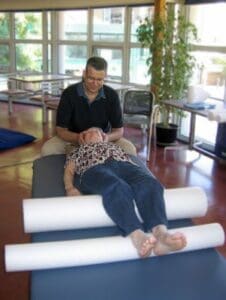A typical lesson

Initial lessons are usually conducted lying down on a cushioned table although lessons whilst sitting and standing also happen. We ask you to wear comfortable loose fitting clothes. We will gently move various parts of your body, maybe the head, legs or pelvis for example, in a slow and gentle manner with the intention to help you and your brain learn new movement possibilities. We help you become aware of habitual body positions and movements, which, unknown to you, may be the cause of pain and discomfort. We also help you discover new ways of moving that are more compatible with your body’s natural design, lessons are a learning experience.
Sometimes the impact of a lesson is immediate. When you come to stand you may feel lighter, taller, more flowing and be able to make pain free easy movements with a greater range of motion. Sometimes you may feel the result later. You may find that you can reach higher than before or maybe bend down more easily.
Lessons with children are conducted in a similar way although a child might be more active or less able to understand what we are doing so we blend with the natural state that they bring to the lesson. Toys , singing and other “play” activities often become incorporated into the lesson as we will use whatever resources needed to generate the learning experience we seek.
A lesson will last for about 45 minutes although we do not operate on a strict timetable and prefer to work in a manner that is conducive to maximizing learning.
History and how it works
The Feldenkrais Method was developed by Israeli physicist and Judo master Dr. Moshe Feldenkrais in the 1950s after he suffered a severe sports injury. By using science and his martial arts background and studying how body movement influences the brain, Dr. Feldenkrais was able to learn to walk again. He found that people could reduce stress and ease pain and stiffness by learning to develop efficient and flexible movement. Feldenkrais combines anatomy, biology, physics, neurology and physiology with elements of martial arts to reeducate the mind and body. Anat Baniel has taken the method forward using current research from areas such as brain plasticity together with over thirty years experience in applying the work.
Negative habitual movement patterns lead to stress and strain in the muscles. For example, your skeleton and many different muscles are affected by slumping your back. In time, your whole body, from head to toes, feels the strain of cramped movements and out-of-balance postures which can lead to chronic pain and other conditions such as headaches. As we go through life we develop habitual ways of moving to accommodate injuries or traumas that may have served us well at the time, but those movements may be hampering us today without our knowing.
As practitioners we are as gentle as some other body workers are vigorous. Our job is to literally feel what your body is trying to say and communicate that to your brain. Often the messages are subtle and using a principle of reduced effort we can help your brain understand these subtle messages and us them to incorporate into new ways of moving.
A Feldenkrais session doesn’t just solve your immediate problems. Our purpose is to help you become aware of your body’s capabilities. Once you discover your body’s natural ability to move, you’ll find more comfortable ways of standing, sitting, walking and more.